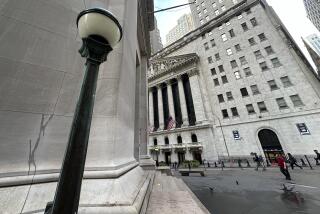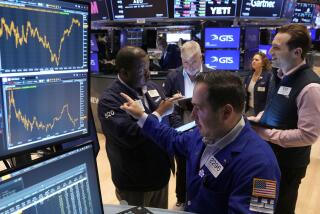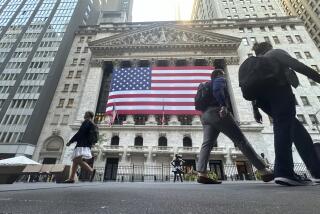Stocks Jump 82 in Best One-Day Gain in 2 1/2 Years
A sharp decline in bond interest rates sent stocks to their biggest one-day rally in 2 1/2 years on Tuesday, triggering hopes that the recent selloff may finally be subsiding.
The Dow Jones industrial average, which had been down nearly 400 points from its record Jan. 31 high, soared 82.06 points to close at 3,675.41. The rally was sparked by a significant drop in the closely watched yield on 30-year Treasury bonds, which fell in response to a government report showing that robust economic growth may be easing. Slower growth could reduce pressure on the Federal Reserve to hike interest rates further.
Among Orange County companies, 65 stocks closed higher on Tuesday, 27 were unchanged and eight were down.
While Tuesday’s rally--only the second “up” day in eight trading sessions--cheered investors, experts cautioned against interpreting it as a definitive signal that stocks have finally ended their free fall.
“Days like today are nice, but I don’t think it’s a total reversal yet,” said Steven DeLuca, an analyst with venture capital company Cruttenden & Co. Inc. in Irvine. He said there is concern that Tuesday’s big gain was more a matter of short sellers covering their positions than a true sign of investor confidence.
Many analysts predicted still more market volatility ahead. Tuesday’s market surge, said several analysts, should be seen as a natural reaction to the recent spate of selling.
“This rally doesn’t reflect a fundamental shift in the economy or a change in investor psychology or some new consumer confidence,” said Hugh Johnson, chief investment officer at the First Albany brokerage house, based in Albany, N.Y. “It was just a buying spree in the wake of an oversold, down market.”
Johnson said institutional investors, such as big pension funds, had been waiting for an opportunity to take advantage of bargains among some stocks. “When you have this many edgy, itchy portfolio managers, it doesn’t take much to get them going,” he said.
Individual investors, whose billions of dollars in mutual fund accounts have fueled the generally uninterrupted growth in stock prices in recent years, were again advised to remain calm and to stick with their existing investment strategies rather than attempt to time their moves to the market’s expected gyrations.
“You have to sit through these down periods with your plan intact,” said Dan Jamieson, editor of Registered Representative, an Irvine-based magazine for stock brokers. “This is when good brokers earn their money.”
Indeed, although some buying of mutual fund shares was reported on Tuesday, individual investors generally were still on the sidelines, preferring to ride out the recent market instability.
“The markets are in their greatest turmoil in five years,” said John Wilson, chief economist for Bank of America. “We don’t know how strong the economy really is, when interest rates are going to rise and whether inflation is about to resume. It’s going to be a bumpy road until the end of the year.”
The big uncertainty is whether the economy’s continued growth is too much of a good thing that will ultimately lead to a renewed bout of price increases. To keep inflation in check, the Federal Reserve has raised interest rates twice this year--the first such hikes in five years--and could do so a third time soon.
Rising interest rates, as reflected in higher yields on savings deposits and bonds, tend to attract money away from stocks.
But bond yields declined on Tuesday following a Commerce Department report early in the day that its index of leading economic indicators dipped 0.1% in February, the first decline in seven months. Although much of the drop was attributed to severe winter weather, the report was widely interpreted as showing that economic growth and inflation might not be as strong as some investors had feared.
The yield on the benchmark 30-year Treasury bond fell to 7.24%, after soaring to 7.40% on Monday following a report last week of a greater-than-expected jump in new jobs. Monday’s yield was the highest since January, 1993.
Until Tuesday’s trading, 30-year bond yields had risen about 1.5 percentage points from their bottom of last October--a sharp rise that had startled economists because it appeared to be greater than the economy warranted.
Gary Schlossberg, chief economist at Wells Fargo Bank in San Francisco, said inflation on consumer goods is likely to remain stable despite higher buying demand because of fundamental changes in the international economy, including deregulation of key industries, declining strength of labor unions and widespread global competition in manufacturing.
Interest rates had risen so sharply because “the market was magnifying the slim chance that inflation would take over and was pricing itself for that, rather than for the reality of the situation,” said David Berson, chief economist for the Federal National Mortgage Assn. in Washington.
Berson said he expects the stock market to spend the next several months “sorting itself out relative to the economy.” When that happens, he predicts that stocks will surge because business is generally strong and corporate profits are increasing.
Stocks in industries sensitive to the economic cycles, such as autos, heavy machinery and chemicals, led Tuesday’s advance. The 82-point jump in the Dow Jones average was its largest increase since Dec. 23, 1991, when it leaped 88 points.
It also was the fourth biggest one-day surge ever in the index. On Jan. 17, 1991, the Dow climbed a record 114.6 points after U.S.-led forces began their air assault on Iraq.
Times staff writer Anne Michaud in Costa Mesa contributed to this report.
* TOUGH COMEBACK: Stocks still must overcome new investor caution. D1
More to Read
Inside the business of entertainment
The Wide Shot brings you news, analysis and insights on everything from streaming wars to production — and what it all means for the future.
You may occasionally receive promotional content from the Los Angeles Times.










